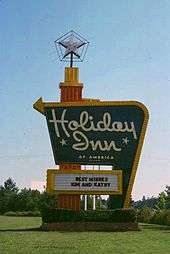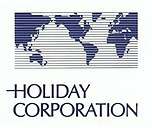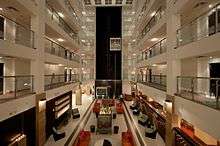Holiday Inn
Holiday Inn is a British-owned American brand of hotels, and a subsidiary of InterContinental Hotels Group. Founded as a U.S. motel chain, it has grown to be one of the world's largest hotel chains, with 1,173 active hotels and over 214,000 rentable rooms as of September 30, 2018.[3] The hotel chain's headquarters are in Denham, Buckinghamshire.
 | |
| Subsidiary of the InterContinental Hotels Group | |
| Industry | Hotels |
| Founded | August 1, 1952 Memphis, Tennessee, United States |
| Founder | Kemmons Wilson |
| Headquarters | Denham, Buckinghamshire, United Kingdom |
Number of locations | 1,145 (September 30, 2016)[1] |
Area served | Americas, Europe, Middle East, Africa, Asia-Pacific |
| Services | Food services, lodging, conventions, meetings, timeshares |
| Owner | InterContinental Hotels Group |
| Divisions | Holiday Inn Express |
| Website | www |
| Footnotes / references [2] | |
History
1950s–1970s

Kemmons Wilson, a resident of Memphis, Tennessee, was inspired to build his own motel after being disappointed by poor quality and inconsistent roadside accommodation during a family road trip to Washington, D.C. The name "Holiday Inn" was coined by Wilson's architect Eddie Bluestein as a joke during construction of the first hotel, in reference to the 1942 Christmas-themed, musical film Holiday Inn, starring Bing Crosby and Fred Astaire. Their first hotel/motel opened in August 1952 as "Holiday Inn Hotel Courts" at 4925 Summer Avenue in Memphis, the main highway to Nashville. In the early 1990s it was demolished, leaving behind a plaque commemorating the site.
Wilson partnered with Wallace E. Johnson to build additional motels on the roads entering Memphis.[4] At the time Holiday Inn's corporate headquarters was in a converted plumbing shed owned by Johnson. In 1953, the company built its next three hotels which, along with their first hotel, covered the roads that led to Memphis. The second motel was built on U.S. 51 South. It was followed by two more in 1953, one on Highway 51 North, and another on U.S. 61. Upon Johnson's death in 1988, Wilson was quoted as saying, "The greatest man I ever knew died today. He was the greatest partner a man could ever have." What they started together, with Wilson later helming the project, became the Holiday Corporation, one of the world's largest hotel groups.
By the beginning of 1956, there were 23 Holiday Inns operating with seven more due to open by the year's end. In 1957, Wilson began marketing the chain as "Holiday Inn of America", mandating its properties be standardized, clean, predictable, family-friendly, and readily accessible to road travelers. The chain grew dramatically as a result, with 50 locations across the country by 1958, 100 by 1959, 500 by 1964, and the 1,000th Holiday Inn (in San Antonio, Texas) opening in 1968.[5]
In 1965, the chain launched Holidex, a centralized reservation system where a visitor to any Holiday Inn could obtain reservations, by teleprinter, for any other Holiday Inn location. The only comparable systems at the time were operated by airlines (Sabre made its debut in 1963). Promoting itself as "your host from coast to coast", Holiday Inn added a call center after AT&T's introduction of +1-800 toll-free telephone number service in 1967, and updated its systems as desktop microcomputers, an invention of the 1970s, found their way into travel agencies.[6]
Branded as "The Nation's Innkeeper", the chain put considerable financial pressure on traditional motels and hotels, setting the standard for competitors like Ramada Inn, Quality Inn, Howard Johnson's, and Best Western. By June 1972, with over 1,400 Holiday Inns worldwide, Wilson was featured on the cover of Time magazine and the franchise's motto became "The World's Innkeeper".
In the 1960s, Holiday Inn began franchising and opening campgrounds under the Holiday Inn Trav-L-Park brand. These recreational campgrounds were listed in the Holiday Inn directories.[7][8]
In 1963, Holiday Inn signed a long-term deal with Gulf Oil Corporation where it agreed to accept Gulf credit cards to charge food and lodging at all of its American and Canadian hotels, in return for Gulf building service stations on many Holiday Inn properties, particularly near major U.S. and Interstate highways. The arrangement was copied by competing lodging chains and major oil companies during the mid-to-late 1960s, but fell out of favor following the 1973 oil crisis. The Gulf/Holiday Inn arrangement ended around 1982.
In 1971, the company constructed the Holiday Inn University and Conference Center, a teaching hotel for training new employees, in Olive Branch, Mississippi. In 1973, the company built the Olive Branch Airport north of the University as a home base for its corporate aircraft.
The company later branched into other enterprises, including Medi-Center nursing homes, Continental Trailways, Delta Queen, and Show-Biz, Inc., a television production company that specialized in syndicated country music shows. Wilson also developed the Orange Lake Resort and Country Club near Orlando and a chain called Wilson World Hotels. The acquisition of Trailways in 1968 lasted until 1979, when Holiday Inn sold Trailways to private investor Henry Lea Hillman Sr of Pittsburgh, Pennsylvania. In the years during which Trailways was a subsidiary of Holiday Inn, television commercials for Holiday Inn frequently showed a Trailways bus stopping at a Holiday Inn hotel. Wilson retired from Holiday Inn in 1979. As of 2014, Wilson's family still operates hotels as part of the Kemmons Wilson Companies of Memphis.
The Great Sign

The "Great Sign" was the roadside sign used by Holiday Inn during its original era of expansion from the 1950s to 1970s. It was perhaps the company's most successful form of advertising. It was extremely large and eye-catching, but was expensive to construct and operate. The manufacturer of the sign was Balton & Sons Sign Company, and it was originally designed by sketch artists Gene Barber and Roland Alexander. Wilson wanted a prominent sign, desiring that it be at least 50 feet (15 m) high and visible in both directions. He also wanted a changeable marquee to welcome different groups. The original sign cost $13,000.[9] It is said that the sign's colors were selected because they were favorites of Wilson's mother. The popularity of the sign led to many imitations, some of which remain to this day.
In 1982, following Wilson's departure, the Holiday Inn board of directors phased out the "Great Sign" in favor of a cheaper back-lit sign. The decision essentially signaled the end of the Wilson era, and Wilson considered it "the worst mistake they ever made". He loved the "Great Sign" so much that it was engraved on his tombstone, with the marquee reading "FOUNDER" and the arrow aimed at his name.[10] The majority of the signs were sold as scrap metal and recycled.
Several intact fragments of the famous sign have been restored and relit, mostly the Holiday Inn top section of the sign and the marquee box. In 2006, a complete sign was found. The disassembled sign, complete with star, marquee box, and the sign base, was discovered in a backlot in Minnesota. On June 3, 2007, it was purchased by a neon sign restoration expert, in order to restore it to its 1950s appearance. It would be displayed at the National Save the Neon Signs Museum in Minot, North Dakota. An intact sign that came from a Las Vegas location stands outside of the American Sign Museum in Cincinnati, Ohio. Another intact and operating Holiday Inn Great Sign is at The Henry Ford Museum in Dearborn, Michigan, and yet another is with a private collector in Park Hills, Kentucky.
1980s–present

Although still a healthy company, changing business conditions and demographics saw Holiday Inn lose its market dominance in the 1980s. Holiday Inns, Inc. was renamed "Holiday Corporation" in 1985 to reflect the growth of the company's brands, including Harrah's Entertainment, Embassy Suites Hotels, Crowne Plaza, Homewood Suites, and Hampton Inn. In 1988, Holiday Corporation was purchased by UK-based Bass PLC (then owners of the Bass beer brand), followed by the remaining domestic Holiday Inn hotels in 1990, when founder Wilson sold his interest, after which the hotel group was known as Holiday Inn Worldwide. The remainder of Holiday Corporation (including the Embassy Suites Hotels, Homewood Suites, and Hampton Inn brands) was spun off to shareholders as Promus Companies Incorporated. In 1990, Bass launched Holiday Inn Express, a complementary brand in the limited service segment.[11][12][13]
In 1997, Bass created and launched a new hotel brand, Staybridge Suites by Holiday Inn, entering the North American upscale extended stay market. In March 1998, Bass acquired the InterContinental brand, expanding into the luxury hotel market. In 2000 Bass sold its brewing assets (and the rights to the Bass name) and changed its name to Six Continents PLC. InterContinental Hotels Group (IHG) was created in 2003 after Six Continents split into two daughter companies: Mitchells & Butlers PLC to handle restaurant assets, and IHG to focus on soft drinks and hotels, including the Holiday Inn brand.[14]
The brand name Holiday Inn is now owned by IHG, which in turn licenses the name to franchisees and third parties who operate hotels under management agreements.[15]
In 1999, the hotel that changed into the Nickelodeon Suites Resort Orlando in 2005, opened, called "Holiday Inn".
The Wall Street Journal reported in 2002 that the company, led by Ravi Saligram, was producing a new 130-room "Next Generation" prototype hotel to rebuild the brand. It would include a bistro-like restaurant and an indoor pool. The first of these prototype hotels, the Holiday Inn Gwinnett Center, was built in Duluth, Georgia, in 2003.
On October 24, 2007, IHG announced a worldwide relaunch of the Holiday Inn brand, which spelled trouble for the remaining motels. The relaunch was "focused on delivering consistently best in class service and physical quality levels, including a redesigned welcome experience [and] signature bedding and bathroom products". The first relaunched Holiday Inn opened in the U.S. in spring 2008. Currently there are more than 2,500 relaunched Holiday Inn brand hotels around the world, and the Holiday Inn global brand relaunch process was completed by the end of 2010.[16] By then, the majority of the HI motels were removed from the chain, with a few exceptions. (In the 1980s and 1990s, HI hotels were built alongside the motel properties [i.e. Baton Rouge, Louisiana] in order to provide more amenities and newer rooms.) When the relaunch occurred, these motels were either demolished or closed off, even if a full-service hotel was already on site. Today, fewer than 10 Holiday Inn motels still operate, others having been replaced by newer Holiday Inn Express locations or having switched to other chains.
In September 2008, IHG announced the creation of a new timeshare brand, Holiday Inn Club Vacations, a strategic alliance with The Family of Orange Lake Resorts.[17]
Logos
 1985–1990
1985–1990 2003–2007
2003–2007 2007–2016
2007–2016
Brands

- Holiday Inn – This is the most recognizable tier of service. There are two distinct types: high-rise, full-service plaza hotels and low-rise, full-service hotels. The former also included many high-rises with round, central-core construction, instantly recognizable from the 1970s. Both offer a restaurant, pools at most locations, room service, an exercise room, and functional but comfortable rooms.
- Holiday Inn Hotel & Suites – The properties offer all the amenities and services of a regular Holiday Inn but consist of rooms mixed with suites.
- Holiday Inn Resort – The properties also offer all the amenities and services of a full-service Holiday Inn; resorts are considered more of an advertising branding than a completely different brand. Most Holiday Inn Resorts are located in high-leisure-tourism markets.
- Holiday Inn Club Vacations – Vacation Ownership / Timeshare villas that offer more space and amenities than a standard hotel room. The brand was formed as part of a strategic marketing alliance with Orange Lake Resorts, which owns 26 resorts across the United States. Orange Lake Resorts was started by Kemmons Wilson, the founder of Holiday Inn. The company is still owned and operated by the Wilson family.
- Holiday Inn Club Vacations are also owned by Landry's Inc.
- Holiday Inn Select – These upper-range full-service hotels cater to business travelers, and are often located next to international airports. In 2006 it was announced that Holiday Inn Select hotels would be discontinued. Existing hotels may continue to operate under the Holiday Inn Select flag until their existing license expires, however many are converting to Crowne Plaza or regular Holiday Inn hotels, with no further marketing or advertising based around the "Select" moniker. Several Select hotels remained as of 2014.
- Holiday Inn Club Vacations – These are resorts aimed at families and are only based in the U.S. The accommodations are mostly villas and suites. Membership operates similar to a flexible timeshare basis.
- Holiday Inn Garden Court – The properties exist only in Europe and South Africa and are designed to reflect the national culture.
- Holiday Inn Express – These properties originally focused on economy and limited service, very similar to competitors like Comfort Inn/Comfort Suites, Fairfield Inn & Suites by Marriott and Hampton by Hilton, providing only continental breakfast and an exercise room. However newer Holiday Inn Express do feature most amenities from the higher-end Holiday Inn brand, such a restaurant and bar, conference rooms, and even a full fitness center with a swimming pool. A major differentiation is location, with Express properties typically found in suburbs and along freeways, while the upmarket Holiday Inn has been placed in urban areas (including downtowns) and often near tourist attractions.
Other
Although originally called "Holiday Inn Crowne Plaza", the Crowne Plaza division was separated from Holiday Inn in 1994 to form a distinctive brand.
During the 1960s and 1970s, there were several Holiday Inn Jr. motels with just 44 to 48 guest rooms located in portables. Locations included Camden, Arkansas; Rantoul, Illinois; Cleveland, Mississippi; Sardis, Mississippi; Farmington, Missouri; Springfield, Tennessee; and Columbus, Texas. A traditionally constructed lobby building featured a Holiday Grill restaurant. The Camden location had just 32 rooms while the Rantoul location had 64 rooms.
Holiday Inn Magazine was a monthly publication for guests during the 1970s. It featured travel destination and attraction stories in addition to a featured hotel property.
Neil Diamond composed the song "Holiday Inn Blues" which was released on the Velvet Gloves and Spit album in 1968. The humorous song laments on the rigors of an upcoming artist and his band touring in rented station wagons and staying in Holiday Inn hotels at each tour stop, trying to get rooms, and in one city where the hotel was near occupancy, the band was stuck into the bridal suite replete with a good view of the hotel's new parking lot.
Elton John and Bernie Taupin composed the song "Holiday Inn" which was released on the Madman Across the Water album in 1971. Elton explains to audiences that during their first years of touring across America, they would stay in the same identical rooms no matter where they were. As Bernie summed up in the lyrics, "From a terminal gate to a black limousine, it's a ten-minute ride to the Holiday Inn".[18]
The Who were banned from a Holiday Inn due to substantial property destruction by the band, especially Keith Moon.
Jimmy Buffett mentions the chain in his song Cheeseburger in Paradise '...Reminds me of the menu at a Holiday Inn...'
Trademark conflicts
- For two decades a hotel called Holiday Inn located in Niagara Falls, Ontario prevented the Holiday Inn Corporation from operating one of its own hotels in that city since the name was already in use. The hotel used a logo similar to the old Holiday Inn logo from the 1970s. The Holiday Inn Corporation directory referred to the hotel as "not part of this Holiday Inn system". The hotel also owned the holidayinn.com domain,[19] which forced the much larger corporation to use holiday-inn.com. In 2006, an agreement between IHG and the Niagara Falls, Ontario hotel owners was reached that allowed both the Hotel and Holidayinn.com to be incorporated into the IHG system.[20]
- During the 1960s and early 1970s, Holiday Inn hotels located in Myrtle Beach, South Carolina were simply called "Holiday" because a local motel already had the "Holiday Inn" name. The Myrtle Beach motel started as Ocean Front Lodge in 1948 but changed the name to Holiday Inn in 1949 (three years before the founding of the chain), and put up a sign in 1955 with similar lettering to that of the chain, which registered its sign in 1954. The chain first franchised motels in the area in 1956. The Myrtle Beach hotel put up a sign resembling the "Great Sign" in 1968, and used "®" with its name, though many of its items came from suppliers which assumed they were selling to the chain.[21] The Myrtle Beach hotel "began a concurrent use proceeding in the Patent and Trademark Office" in 1970, which was suspended[22] when the name was contested before the United States District Court for the District of South Carolina (Florence division) in 1973.[21] The court said the Myrtle Beach hotel had plenty of repeat business and was not negatively impacted by the chain's motels in the area. The 1973 injunction meant the Myrtle Beach hotel was granted the right to use the name but with a different style of lettering. The concurrent use proceeding resumed for the Myrtle Beach hotel, which continued to operate as "Holiday Inn", although it was required to use a distinctly different font. A 1976 ruling granted the Myrtle Beach hotel the right to a service mark. A 1979 order denied a motion to modify the 1973 injunction, though it was believed the hotel had followed all restrictions. A 1981 decision by the 4th Circuit Court of Appeals upheld the 1979 action.[22]
See also
- List of chained-brand hotels
- List of hotels
References
- "Holiday Inn Hotels & Resorts - Our brands - InterContinental Hotels Group PLC". InterContinental Hotesl Group. Retrieved October 10, 2017.
- "Supplementary Information" (PDF). International Hotels Group. March 31, 2009. Retrieved June 6, 2009.
- "Holiday Inn". development.ihg.com. Retrieved February 2, 2019.
- "Wallace E. Johnson: Co-founder of Holiday Inn chain". Los Angeles Times. April 29, 1988. Retrieved June 25, 2012. Fowler, Glenn (April 29, 1988). "Wallace E. Johnson, Co-founder of Holiday Inns chain in 1950's". New York Times. Retrieved June 25, 2012.
- Rob Baker (December 4, 2014). "Twenty Humdrum Holiday Inn Postcards from the Fifties and Sixties". Flashbak.
- "HNN - Hoteliers bid adieu as Holidex checks out". Hotelnewsnow.com. Retrieved April 14, 2017.
- "Removed From Timesharing, Jon DeHaan Stays Busy In Other Ways". Ampersandcom.com. Retrieved December 11, 2011.
- "Daytona Beach Morning Journal - Google News Archive Search". google.com.
- Half Brains and Half Luck by Kemmons Wilson. p 52-53
- Caitlin L. Horton. "The Holiday Inn Great Sign". Memphis Type History. Retrieved April 14, 2017.
- Wade, Betsy (December 16, 1990). "On the Road, Sleeping for Less". The New York Times.
- "You get what you pay for in economy motels". The News and Courier/Evening Post, Charleston, SC. November 11, 1990.
- "Holiday Inn Enters New Market Area". Daily News, Bowling Green, Kentucky. October 8, 1990.
- "Our History". InterContinental Hotels Group. January 9, 2008. Retrieved June 6, 2009.
- Barbara De Lollis (July 23, 2007). "Holiday Inn chain gives itself a face-lift". USA Today. Retrieved August 3, 2007.
- InterContinental Hotels Group PLC. "InterContinental Hotels Group (IHG) announces worldwide brand relaunch of Holiday Inn (24 October 2007)" (Press release).
- "Holiday Inn Hotels & Resorts". InterContinental Hotels Group. May 12, 2009. Retrieved June 6, 2009.
- Bernie T. Jauptin - Discography
- "Welcome To The Holiday Inn By The Falls Website". April 3, 1997. Archived from the original on April 3, 1997. Retrieved April 14, 2017.
- http://www.travelweekly.com/Travel-News/Hotel-News/New-Web-address-for-Holiday-Inn-Hotels-and-Resorts
- "Holiday Inns, Inc. v. Holiday Inn, 364 F.Supp. 775 (S.C., 1973)".
- "Holiday Inns, Inc., Appellee, v. Holiday Inn, Appellant, v. Strand Development Corporation, Defendant.,645 F.2d 239".
External links
| Wikimedia Commons has media related to Holiday Inn. |
